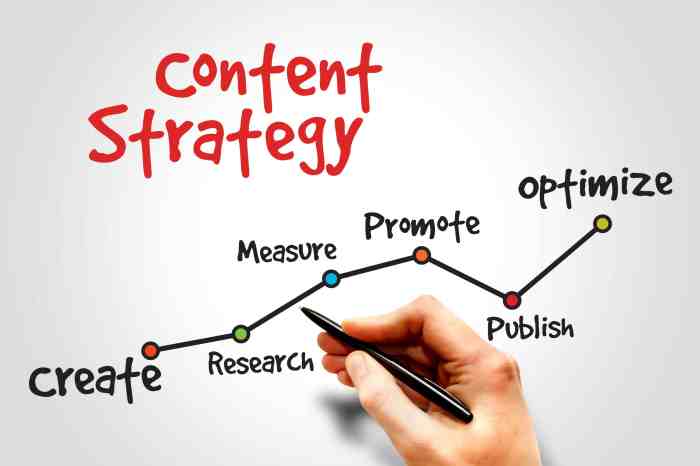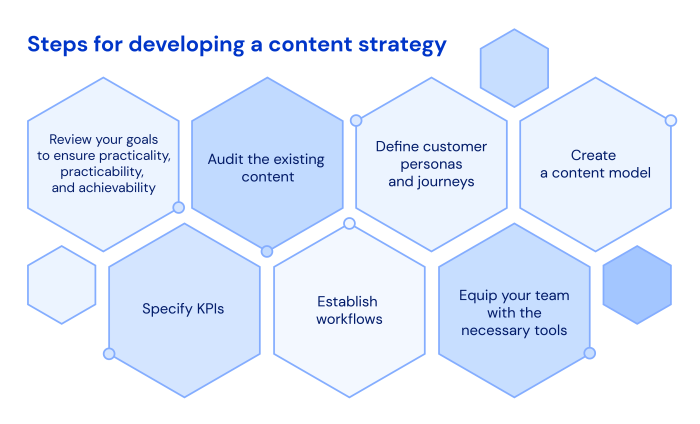Developing a Long-Term Content Strategy sets the stage for sustained success in the digital realm, paving the way for brands to thrive and connect with their audience on a deeper level. Get ready to dive into the core elements that make up a winning content strategy!
Importance of a Long-Term Content Strategy
Having a long-term content strategy is crucial for brands looking to establish a strong online presence and engage with their audience effectively.
Brand Consistency and Customer Loyalty
A well-developed long-term content strategy helps maintain brand consistency across all platforms and channels, ensuring that the brand’s message and values are communicated clearly to the audience.
Consistent content also plays a significant role in building customer loyalty, as it creates a sense of trust and reliability among consumers.
Successful Examples
Brands like Nike, Coca-Cola, and Apple have all benefited greatly from a carefully crafted long-term content strategy.
By consistently delivering high-quality content that resonates with their target audience, these brands have managed to stay relevant and top-of-mind in their respective industries.
Elements of a Comprehensive Content Strategy

Developing a long-term content strategy involves several key components that are essential for success. These elements help in creating a cohesive plan that aligns with your overall goals and objectives. Let’s dive into the key components that should be included in a long-term content strategy.
Role of Audience Research
Audience research plays a crucial role in shaping a long-term content strategy. By understanding your target audience’s preferences, behaviors, and interests, you can create content that resonates with them on a deeper level. This research helps in identifying the right topics, formats, and channels to reach your audience effectively. It also allows you to tailor your messaging to address their pain points and provide valuable solutions. Ultimately, audience research helps in building stronger relationships with your audience and driving better engagement over time.
Setting Clear Goals and KPIs
Setting clear goals and key performance indicators (KPIs) is vital when developing a content strategy. These goals should be specific, measurable, achievable, relevant, and time-bound (SMART). By defining clear objectives, you can track the performance of your content initiatives and assess their impact on your overall business goals. KPIs help in measuring the success of your content strategy, whether it’s increasing website traffic, generating leads, improving brand awareness, or driving conversions. Having clear goals and KPIs in place ensures that your content efforts are aligned with your business objectives and can be optimized for maximum results.
Creating Engaging Content for Long-Term Success

When it comes to creating content that stands the test of time, focusing on evergreen topics is key. Evergreen content remains relevant regardless of when it is consumed, making it valuable in the long run.
Tips for Creating Evergreen Content, Developing a Long-Term Content Strategy
One tip for creating evergreen content is to focus on timeless topics that are always relevant to your audience. Avoid trends that may quickly become outdated.
- Research common pain points or questions your audience has and address them in your content.
- Create comprehensive guides or tutorials that can serve as go-to resources for your audience.
- Update your evergreen content regularly to ensure it remains accurate and valuable over time.
The Role of Storytelling in Capturing Audience Attention
Storytelling is a powerful tool for engaging your audience and keeping them invested in your content. By weaving narratives into your content, you can create a connection with your audience and make your message more memorable.
- Use personal anecdotes or case studies to illustrate key points and make your content relatable.
- Create a consistent brand voice and style that resonates with your audience and keeps them coming back for more.
- Focus on creating emotional connections through your storytelling to evoke strong responses from your audience.
Strategies for Repurposing Existing Content
Repurposing existing content is a great way to extend the life of your work and reach new audiences. By recycling and reimagining your content, you can keep it fresh and engaging over the long term.
- Turn blog posts into podcasts or videos to reach audiences who prefer different formats.
- Create infographics or slideshows using data from your existing content to present information in a visually appealing way.
- Update and expand upon older content to provide new insights and keep your audience coming back for more.
Implementing and Evaluating a Long-Term Content Strategy: Developing A Long-Term Content Strategy
Implementing a long-term content strategy across various digital platforms is crucial for maintaining a consistent brand presence and engaging with your target audience. By following specific steps, you can ensure that your content strategy is effective and sustainable over time.
Steps for Implementing a Long-Term Content Strategy
- Create a detailed content calendar outlining topics, publishing schedule, and target s for each piece of content.
- Research your target audience to understand their preferences, interests, and pain points, tailoring your content to meet their needs.
- Utilize a mix of content types such as blog posts, videos, infographics, and social media posts to keep your audience engaged across different platforms.
- Collaborate with influencers or industry experts to increase the reach and credibility of your content.
- Regularly update and optimize your content based on feedback, trends, and performance data to stay relevant and impactful.
Importance of Regular Performance Monitoring and Analytics
Regularly monitoring the performance of your content strategy through analytics is essential to gauge its effectiveness and make informed decisions for improvement. By analyzing key metrics such as engagement rates, conversion rates, and traffic sources, you can identify what is working well and areas that need adjustment.
Best Practices for Adjusting and Refining a Long-Term Content Strategy
- Identify top-performing content and replicate successful strategies in future campaigns.
- A/B test different elements of your content, such as headlines, visuals, and calls-to-action, to optimize performance.
- Stay updated on industry trends and audience preferences to adapt your content strategy accordingly.
- Seek feedback from your audience through surveys, comments, and social media interactions to understand their needs and expectations.
- Regularly review and adjust your content calendar based on performance data to ensure ongoing relevance and effectiveness.
